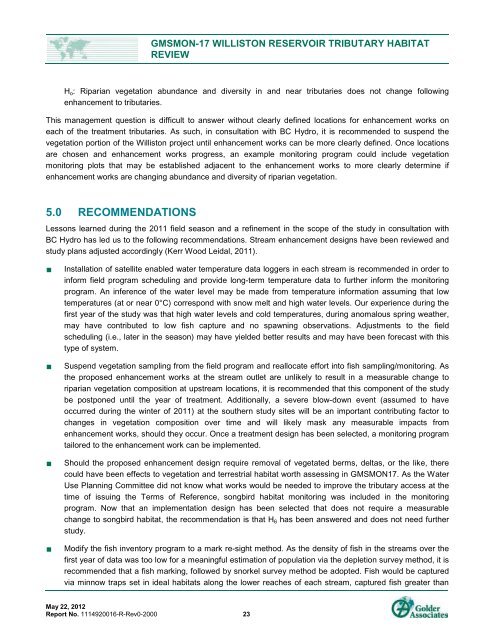GMSMON-17 WILLISTON RESERVOIR TRIBUTARY - BC Hydro
GMSMON-17 WILLISTON RESERVOIR TRIBUTARY - BC Hydro
GMSMON-17 WILLISTON RESERVOIR TRIBUTARY - BC Hydro
You also want an ePaper? Increase the reach of your titles
YUMPU automatically turns print PDFs into web optimized ePapers that Google loves.
May 22, 2012<br />
Report No. 1114920016-R-Rev0-2000 23<br />
<strong>GMSMON</strong>-<strong>17</strong> <strong>WILLISTON</strong> <strong>RESERVOIR</strong> <strong>TRIBUTARY</strong> HABITAT<br />
REVIEW<br />
Ho: Riparian vegetation abundance and diversity in and near tributaries does not change following<br />
enhancement to tributaries.<br />
This management question is difficult to answer without clearly defined locations for enhancement works on<br />
each of the treatment tributaries. As such, in consultation with <strong>BC</strong> <strong>Hydro</strong>, it is recommended to suspend the<br />
vegetation portion of the Williston project until enhancement works can be more clearly defined. Once locations<br />
are chosen and enhancement works progress, an example monitoring program could include vegetation<br />
monitoring plots that may be established adjacent to the enhancement works to more clearly determine if<br />
enhancement works are changing abundance and diversity of riparian vegetation.<br />
5.0 RECOMMENDATIONS<br />
Lessons learned during the 2011 field season and a refinement in the scope of the study in consultation with<br />
<strong>BC</strong> <strong>Hydro</strong> has led us to the following recommendations. Stream enhancement designs have been reviewed and<br />
study plans adjusted accordingly (Kerr Wood Leidal, 2011).<br />
� Installation of satellite enabled water temperature data loggers in each stream is recommended in order to<br />
inform field program scheduling and provide long-term temperature data to further inform the monitoring<br />
program. An inference of the water level may be made from temperature information assuming that low<br />
temperatures (at or near 0°C) correspond with snow melt and high water levels. Our experience during the<br />
first year of the study was that high water levels and cold temperatures, during anomalous spring weather,<br />
may have contributed to low fish capture and no spawning observations. Adjustments to the field<br />
scheduling (i.e., later in the season) may have yielded better results and may have been forecast with this<br />
type of system.<br />
�<br />
�<br />
�<br />
Suspend vegetation sampling from the field program and reallocate effort into fish sampling/monitoring. As<br />
the proposed enhancement works at the stream outlet are unlikely to result in a measurable change to<br />
riparian vegetation composition at upstream locations, it is recommended that this component of the study<br />
be postponed until the year of treatment. Additionally, a severe blow-down event (assumed to have<br />
occurred during the winter of 2011) at the southern study sites will be an important contributing factor to<br />
changes in vegetation composition over time and will likely mask any measurable impacts from<br />
enhancement works, should they occur. Once a treatment design has been selected, a monitoring program<br />
tailored to the enhancement work can be implemented.<br />
Should the proposed enhancement design require removal of vegetated berms, deltas, or the like, there<br />
could have been effects to vegetation and terrestrial habitat worth assessing in <strong>GMSMON</strong><strong>17</strong>. As the Water<br />
Use Planning Committee did not know what works would be needed to improve the tributary access at the<br />
time of issuing the Terms of Reference, songbird habitat monitoring was included in the monitoring<br />
program. Now that an implementation design has been selected that does not require a measurable<br />
change to songbird habitat, the recommendation is that H6 has been answered and does not need further<br />
study.<br />
Modify the fish inventory program to a mark re-sight method. As the density of fish in the streams over the<br />
first year of data was too low for a meaningful estimation of population via the depletion survey method, it is<br />
recommended that a fish marking, followed by snorkel survey method be adopted. Fish would be captured<br />
via minnow traps set in ideal habitats along the lower reaches of each stream, captured fish greater than
















